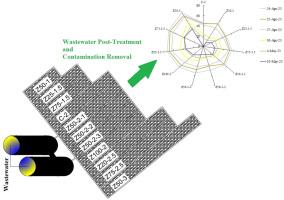使用沸石透水混凝土对城市污水进行后处理
IF 6.3
2区 工程技术
Q1 ENGINEERING, CHEMICAL
引用次数: 0
摘要
本研究旨在评估沸石透水混凝土 (ZPC) 作为一种后处理方法在改善 Parkand Abad 废水处理厂 (PAWWTP) 排放废水水质方面的有效性,重点关注不同的 ZPC 成分和水渠长度对去除废水中污染物的影响。我们建造了一个大型原型,11 条不同长度(1-3 米)的水渠中填充了不同的 ZPC 混合物,其中石灰石骨料部分被沸石(0-100% 体积比)取代。废水被连续泵入这些水渠,并随着时间的推移测量废水的质量参数。实验装置通过 17 天内一致的流速和多个采样点进行了验证,确保了数据收集的可靠性。结果表明,较长的水渠和较高的沸石含量提高了后处理效率。化学需氧量(COD)去除率最初达到 45%,但随着时间的推移降至 10%以下。生化需氧量(BOD)、总悬浮固体(TSS)和总氮(TN)的去除率很高,最初分别超过 80%、70% 和 50%。TP 最初的去除率为 70%,实验结束时仍为 70%。这些发现意义重大,因为它们证明了 ZPC 作为一种有效、低成本的废水后处理方法的潜力。该研究强调了优化 ZPC 成分和管道长度以最大限度去除污染物的重要性,同时还确定了需要改进的地方,如减少水泥含量和定期维护以提高长期性能。本文章由计算机程序翻译,如有差异,请以英文原文为准。

Post-treatment of municipal wastewater using zeolite pervious concrete
This study aimed to evaluate the effectiveness of Zeolite Pervious Concrete (ZPC) as a post-treatment method for improving discharged wastewater quality from the Parkand Abad Wastewater Treatment Plant (PAWWTP) with a focus on how varying ZPC compositions and canal lengths affect the removal of contaminants from wastewater. A large-scale prototype was constructed with eleven canals of varying lengths (1–3 m) filled with different ZPC mixtures, where limestone aggregate was partially replaced with zeolite (0–100 % by volume). Wastewater was continuously pumped through these canals, and quality parameters of wastewater were measured over time. The experimental setup was validated through consistent flow rates and multiple sampling points over 17 days, ensuring reliable data collection. Results showed that longer canals and higher zeolite content improved post-treatment efficiency. Chemical oxygen demand (COD) removal initially reached 45 % but decreased to below 10 % over time. Biochemical oxygen demand (BOD), total suspended solids (TSS), and total nitrogen (TN) removal rates were promising, with over 80 %, 70 %, and 50 % removal initially. TP was fully removed initially and remained at 70 % by the experiment's end. These findings are significant as they demonstrate ZPC's potential as an effective, low-cost post-treatment method for wastewater. The study highlights the importance of optimizing ZPC composition and canal length for maximum contaminant removal, while also identifying areas for improvement such as reducing cement content and implementing regular maintenance to enhance long-term performance.
求助全文
通过发布文献求助,成功后即可免费获取论文全文。
去求助
来源期刊

Journal of water process engineering
Biochemistry, Genetics and Molecular Biology-Biotechnology
CiteScore
10.70
自引率
8.60%
发文量
846
审稿时长
24 days
期刊介绍:
The Journal of Water Process Engineering aims to publish refereed, high-quality research papers with significant novelty and impact in all areas of the engineering of water and wastewater processing . Papers on advanced and novel treatment processes and technologies are particularly welcome. The Journal considers papers in areas such as nanotechnology and biotechnology applications in water, novel oxidation and separation processes, membrane processes (except those for desalination) , catalytic processes for the removal of water contaminants, sustainable processes, water reuse and recycling, water use and wastewater minimization, integrated/hybrid technology, process modeling of water treatment and novel treatment processes. Submissions on the subject of adsorbents, including standard measurements of adsorption kinetics and equilibrium will only be considered if there is a genuine case for novelty and contribution, for example highly novel, sustainable adsorbents and their use: papers on activated carbon-type materials derived from natural matter, or surfactant-modified clays and related minerals, would not fulfil this criterion. The Journal particularly welcomes contributions involving environmentally, economically and socially sustainable technology for water treatment, including those which are energy-efficient, with minimal or no chemical consumption, and capable of water recycling and reuse that minimizes the direct disposal of wastewater to the aquatic environment. Papers that describe novel ideas for solving issues related to water quality and availability are also welcome, as are those that show the transfer of techniques from other disciplines. The Journal will consider papers dealing with processes for various water matrices including drinking water (except desalination), domestic, urban and industrial wastewaters, in addition to their residues. It is expected that the journal will be of particular relevance to chemical and process engineers working in the field. The Journal welcomes Full Text papers, Short Communications, State-of-the-Art Reviews and Letters to Editors and Case Studies
 求助内容:
求助内容: 应助结果提醒方式:
应助结果提醒方式:


